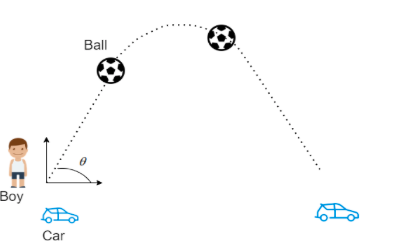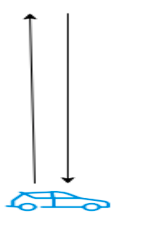
A boy throws a ball in air at ${60^ \circ }$ to the horizontal along a road with a speed of $10m/s$, another boy sitting in a passing car observes the ball. What is the trajectory of the ball observed by the boy in the car if the car has a speed of $18km/h$?
1) Parabolic
2) Straight line
3) Circular
4) Elliptical
Answer
556.5k+ views
Hint: When an object is thrown or projected upward into the air, it is said to be in projectile motion. The object that is projected is known as projectile and the path that the object follows is known as trajectory. In this motion, the acceleration is due to gravity only.
Complete step-By-Step solution:
Step I:
As given, the boy standing on the ground throws the ball at an angle of \[{60^ \circ }\] with the horizontal at a speed of $10m/s$

$\therefore $Horizontal component of the velocity of the ball with respect to the ground is${u_x} = 10\cos \theta $
Since$\theta = {60^ \circ }$, substituting the value and solving
$ \Rightarrow {u_x} = 10\cos {60^ \circ }$
${u_x} = 10 \times \dfrac{1}{2}$
${u_x} = 5m/s$
Step II:
Similarly vertical component of velocity of the ball with respect to the ground is${u_y} = 10\sin \theta $
${u_y} = 10\sin {60^ \circ }$
${u_y} = 10 \times \dfrac{{\sqrt 3 }}{2}$
${u_y} = 5\sqrt 3 m/s$
Step III:
Given that the speed of the car is $ = 18km/h$
Changing km/h to m/s, speed of car becomes$ = 18 \times \dfrac{5}{{18}} = 5m/s$
The horizontal speed of the ball and the car is the same. The relative velocity is the difference of velocities of any two objects with different frames of reference. For the boy sitting in the car is moving horizontally, therefore the relative velocity of the ball with respect to the boy sitting in the car in horizontal direction will be zero.

Only vertical motion of the ball will be observed by the boy in the car which will be a straight line.
$ \Rightarrow $Option 2 is the right answer.
Note: It is important to note that the projectile does not have any other force acting on it except force of gravity. If any other force is acting then the object is not projectile. The force of air resistance is also absent in projectile motion. A projectile moves along a curved path and the acceleration directs it towards the centre of Earth.
Complete step-By-Step solution:
Step I:
As given, the boy standing on the ground throws the ball at an angle of \[{60^ \circ }\] with the horizontal at a speed of $10m/s$

$\therefore $Horizontal component of the velocity of the ball with respect to the ground is${u_x} = 10\cos \theta $
Since$\theta = {60^ \circ }$, substituting the value and solving
$ \Rightarrow {u_x} = 10\cos {60^ \circ }$
${u_x} = 10 \times \dfrac{1}{2}$
${u_x} = 5m/s$
Step II:
Similarly vertical component of velocity of the ball with respect to the ground is${u_y} = 10\sin \theta $
${u_y} = 10\sin {60^ \circ }$
${u_y} = 10 \times \dfrac{{\sqrt 3 }}{2}$
${u_y} = 5\sqrt 3 m/s$
Step III:
Given that the speed of the car is $ = 18km/h$
Changing km/h to m/s, speed of car becomes$ = 18 \times \dfrac{5}{{18}} = 5m/s$
The horizontal speed of the ball and the car is the same. The relative velocity is the difference of velocities of any two objects with different frames of reference. For the boy sitting in the car is moving horizontally, therefore the relative velocity of the ball with respect to the boy sitting in the car in horizontal direction will be zero.

Only vertical motion of the ball will be observed by the boy in the car which will be a straight line.
$ \Rightarrow $Option 2 is the right answer.
Note: It is important to note that the projectile does not have any other force acting on it except force of gravity. If any other force is acting then the object is not projectile. The force of air resistance is also absent in projectile motion. A projectile moves along a curved path and the acceleration directs it towards the centre of Earth.
Recently Updated Pages
Why are manures considered better than fertilizers class 11 biology CBSE

Find the coordinates of the midpoint of the line segment class 11 maths CBSE

Distinguish between static friction limiting friction class 11 physics CBSE

The Chairman of the constituent Assembly was A Jawaharlal class 11 social science CBSE

The first National Commission on Labour NCL submitted class 11 social science CBSE

Number of all subshell of n + l 7 is A 4 B 5 C 6 D class 11 chemistry CBSE

Trending doubts
Differentiate between an exothermic and an endothermic class 11 chemistry CBSE

10 examples of friction in our daily life

One Metric ton is equal to kg A 10000 B 1000 C 100 class 11 physics CBSE

Difference Between Prokaryotic Cells and Eukaryotic Cells

1 Quintal is equal to a 110 kg b 10 kg c 100kg d 1000 class 11 physics CBSE

State the laws of reflection of light




